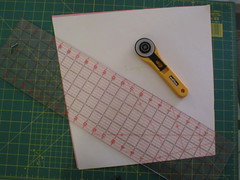I made a banner for MrC’s birthday. I’ve seen several versions of banners all over the crafty and noncrafty web, and I was hooked. But I wasn’t hooked enough to sew a fabric banner. Here is my version of the newspaper and craft paper banner:
Start with a pile of newspapers and pretty craft papers. I made a triangular template (not shown) to trace on the paper.
 |
| From October08 |
I used scissors to cut out the paper because I was too lazy to change the blade in the rotary cutters (I have blades for fabric and blades for paper)… a craft knife would work as well. Put the template on the fold of the newspaper to make a diamond shape when it’s unfolded. Cut out enough for your banner message (I used on diamond per letter).
 |
| From October08 |
At some point, change your mind about the design because you don’t have enough colorful paper to finish the project. Instead of using the colorful craft paper, use plain white paper instead. Use your template to cut out triangles (you don’t need diamonds for this step).
 |
| From October08 |
Glue the triangles to one half of your newspaper diamond.
 |
| From October08 |
Break out some colorful markers, and write your message in bold print.
 |
| From October08 |
Find some twine long enough for your message… attach it to the wall, or the curtain rods, or the roof… wherever you want that message to be displayed. The folded diamond slips over the twine and hangs by itself.
 |
| From October08 |
Wait patiently for hours and hours for the recipient of your message to come home and read it… and be AMAZED you have that much time to make banners and homemade-out-of-this-world cupcakes (sorry, no pics of the cupcakes… but they were GOOD!).
 |
| From October08 |
I don’t have a picture to show but BC and I wrote birthday messages on extra triangles. We nudged the letters together to make room for them. I think that was a better idea than the original banner message. MrC plans to save his notes.



















































